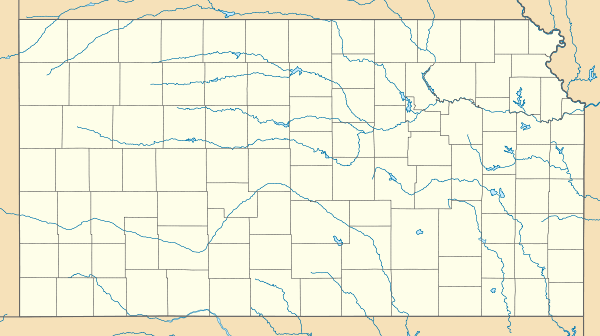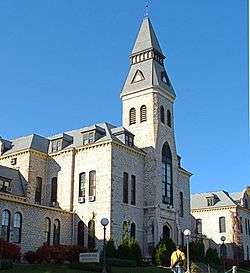Ford Hall (Kansas State University)
Ford Hall is an all-female residence hall at Kansas State University and is named for Kenney L. Ford who was Secretary of the Kansas State Alumni Association from 1928-1961. It is located on the South East corner of the Derby Complex at Kansas State's Manhattan, Kansas campus south of Haymaker Hall and east of West Hall on Manhattan Avenue and Old Claflin Road. It has a residence of approximately 450 students, and all rooms are suites.[1] After the end of the Spring semester, all students move out and some return to live there another year, while others move on to live off-campus or at fraternities and sororities.
| Ford Hall | |
|---|---|
 | |
| General information | |
| Type | Residence Hall |
| Architectural style | Standard white brick |
| Address | Manhattan Ave. and Old Claflin Rd. Kansas State University |
| Town or city | Manhattan, Kansas |
| Country | United States |
| Coordinates | 39°11′37.38″N 96°34′37.09″W |
| Current tenants | 448 students |
| Completed | 1966 |
| Technical details | |
| Floor count | 9 |
| Website | |
| www | |
Awards
2000's
2000-2001
- Homecoming Winner (with Haymaker Hall and Smith Scholarship House) - Residence Hall Division
2003-2004
- Homecoming Winner (with Marlatt Hall and West Hall) - Residence Hall Division
2011-2012
- Homecoming Winner (with Moore Hall and Haymaker Hall (Kansas State University)) - Residence Hall Division
2011-2012
- Hall of the Year - Association of Residence Halls
gollark: Surely you can just pull a particular tag of the container.
gollark: I can come up with a thing to transmit ubqmachine™ details to osmarks.net or whatever which people can embed in their code.
gollark: It's an x86-64 system using debian or something.
gollark: > `import hashlib`Hashlib is still important!> `for entry, ubq323 in {**globals(), **__builtins__, **sys.__dict__, **locals(), CONSTANT: Entry()}.items():`Iterate over a bunch of things. I think only the builtins and globals are actually used.The stuff under here using `blake2s` stuff is actually written to be ridiculously unportable, to hinder analysis. This caused issues when trying to run it, so I had to hackily patch in the `/local` thing a few minutes before the deadline.> `for PyObject in gc.get_objects():`When I found out that you could iterate over all objects ever, this had to be incorporated somehow. This actually just looks for some random `os` function, and when it finds it loads the obfuscated code.> `F, G, H, I = typing(lookup[7]), typing(lookup[8]), __import__("functools"), lambda h, i, *a: F(G(h, i))`This is just a convoluted way to define `enumerate(range))` in one nice function.> `print(len(lookup), lookup[3], typing(lookup[3])) #`This is what actually loads the obfuscated stuff. I think.> `class int(typing(lookup[0])):`Here we subclass `complex`. `complex` is used for 2D coordinates within the thing, so I added some helper methods, such as `__iter__`, allowing unpacking of complex numbers into real and imaginary parts, `abs`, which generates a complex number a+ai, and `ℝ`, which provvides the floored real parts of two things.> `class Mаtrix:`This is where the magic happens. It actually uses unicode homoglyphs again, for purposes.> `self = typing("dab7d4733079c8be454e64192ce9d20a91571da25fc443249fc0be859b227e5d")`> `rows = gc`I forgot what exactly the `typing` call is looking up, but these aren't used for anything but making the fake type annotations work.> `def __init__(rows: self, self: rows):`This slightly nonidiomatic function simply initializes the matrix's internals from the 2D array used for inputs.> `if 1 > (typing(lookup[1]) in dir(self)):`A convoluted way to get whether something has `__iter__` or not.
gollark: If you guess randomly the chance of getting none right is 35%ish.
References
- "Archived copy" (PDF). Archived from the original (PDF) on 2006-07-20. Retrieved 2006-08-09.CS1 maint: archived copy as title (link)
External links
This article is issued from Wikipedia. The text is licensed under Creative Commons - Attribution - Sharealike. Additional terms may apply for the media files.
